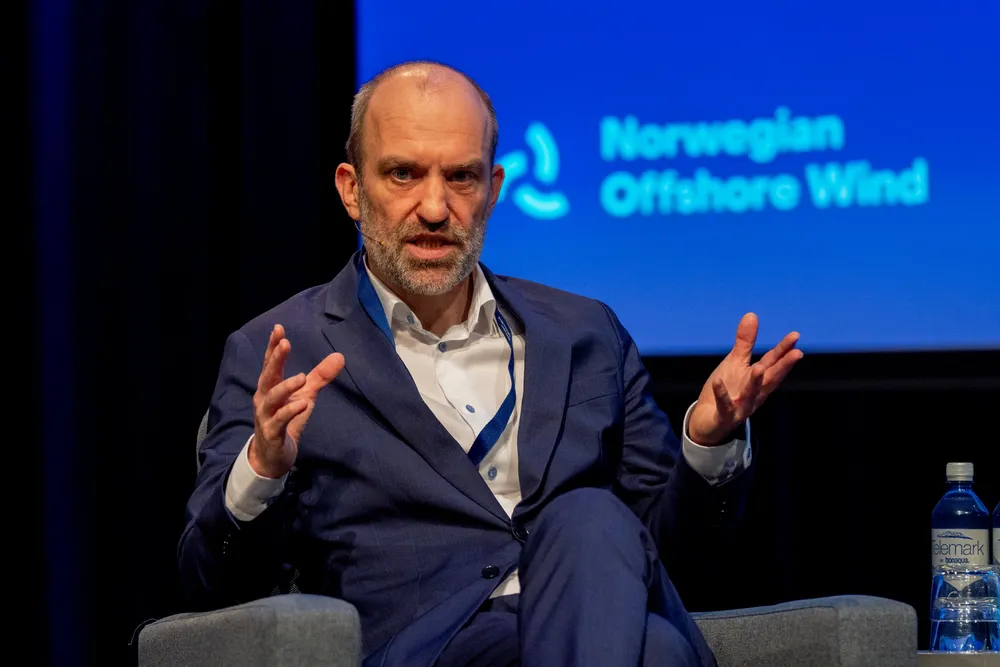Europe 'needs offshore wind supercluster' to stay on pole
Cooperation-minded industry leader claims it is time to buttress Europe's technology lead with new levels of cooperation

European supply chain companies will continue meeting the vast majority of demand from the region’s own offshore wind projects for at least one more decade, new research suggests, amid calls for leading nations to build a "supercluster" in the sector.
The research, carried out on behalf of industry association Norwegian Offshore Wind, analysed projects expected to go through the deployment phase between 2025 and 2035 and found that European-headquartered companies will enjoy market shares averaging 92%.
Several categories, including offshore installation and offshore surveying services were at, or close to, securing a 100% market share for European-headquartered companies, as was the case for full-scope contracts covering engineering, procurement, construction and installation (EPCI) for turbine and substation foundations.
The research, which was conducted by TGS | 4C Offshore, was based on known data from contracts covered in the market intelligence firm’s own forecasts, and did not purport to be a forecast of gross demand in any category.
The study was organised into main categories such as turbines, foundations, substations, surveys and export cables, along with sub-categories such as manufacturing and installation, with findings that suggested that:
- 93% of wind turbines ordered for European projects are being manufactured by European-headquartered companies (1,584 out of 1,708 contracted turbines). In the global market, 44% of a known total of 56,595MW (approximately 4,830 turbines) are being manufactured by European companies.
- 81% of 1,450 wind turbine foundations contracted for European projects will be manufactured by European companies. Market share in the global market was 53%.
- 81% of contracted subsea cables will be manufactured by companies headquartered in the region, falling to a 55% share for global projects. Measured per kilometre, the European share of contracted capacity rose to 91% (8,976km out of 9,875km) in European markets.
- 81% of contracted substation topsides for European projects and 73% outside the region will be met by European-headquartered companies.
Describing itself as an industry cluster made up of 400 domestic and international suppliers and developers, Norwegian Offshore Wind’s purpose in commissioning the research was to further the case for cooperation on a pan-European scale, according to chair Ivar Slengesol.
“In that context, we thought it would be interesting actually to get some hard data on the European suppliers' market share.
“We wanted to underscore that Europe really needs to support its offshore wind industry, because we already have the building blocks for what can be seen as a European supercluster of offshore wind suppliers.”
The outcome of the research, Slengesol concluded, was to show “by a large margin that offshore wind remains a European industry built on European technology”.
“Total turnover for the Norwegian offshore wind supply industry grew 300% between 2018 and 2023,” Slengesol noted, acknowledging that increasing engagement with international markets has been key.
He compares the Norwegian supply chain for oil and gas industries, which draws 80% of its annual revenues of NKr500bn ($48bn) from its domestic market and 20% from overseas.
Inversely, Norwegian offshore wind suppliers obtained just 20% of their annual turnover of NKr43bn from the domestic market, based on 2023 data, but secured 80% of revenues from international customers.
Slengesol stressed the importance of this domestic market but also the need to build pan-European supply chains fit for a world-leading offshore wind sector.
"Of course, a domestic market is important to scale an industry," he said.
"Norwegian suppliers have already shown that they are competitive internationally, particularly in the maritime segments and in cables, but a bigger domestic market will lead to a bigger supply industry. Our own analysis shows this," he said.
Building a 'supercluster'
Slengesol called for Europe to make a concerted effort to help its offshore wind sector "keep pole position".
At industry level, he said, the supply chains of northwestern Europe, in and around the North Sea basin, should step up their efforts to pursue collaboration agreements and develop clusters of the kind already in place in Norway.
"I think we will see more M&A activity as the industry consolidates, but I'd like to see more cross-border collaboration across the segments and suppliers," Slengesol said.
"It is normal to think of ourselves as Norwegian suppliers, or UK suppliers or German suppliers, but we should also equally think European, and part of the European supply chain. This is the European supercluster of offshore wind that we need if we are to build on our pole position."
Slengesol stressed that he was not expecting the European offshore wind sector to be entirely self-sufficient or shielded from competition.
"It's unrealistic to want a purely European supply chain. There will always be components and elements coming from outside Europe, but the knowledge base, the experience and the competitiveness is here, so let’s use it and build on it," Slengesol said.
"Industry clusters like Norwegian Offshore Wind, and similar clusters else are about doing this. Authorities, developers and suppliers all play a critical role in driving these cross-collaborations. We already see it happening, but I think there's potential to do much more."
Slengesol said this kind of pan-European collaboration is also the best response to the geopolitical trends gaining momentum since President Donald Trump regained office.
"A more regionalised trading system is a general political trend, whether we like it or not,” he said.
China concerns
Slengesol also addressed concerns that China, in particular, is leading in some critical areas and some critically important green industries.
"But if you look at deliveries to the offshore wind sector over the next ten years, you see a deeply-rooted European industry that is very competitive," Slengesol added.